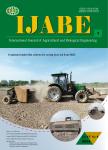Rice seeds identification based on back propagation neural network model
作者机构:College of EngineeringNanjing Agricultural UniversityNanjing 210031China
出 版 物:《International Journal of Agricultural and Biological Engineering》 (国际农业与生物工程学报(英文))
年 卷 期:2019年第12卷第6期
页 面:122-128页
核心收录:
学科分类:0710[理学-生物学] 0810[工学-信息与通信工程] 09[农学] 0805[工学-材料科学与工程(可授工学、理学学位)] 0901[农学-作物学] 0812[工学-计算机科学与技术(可授工学、理学学位)]
基 金:The authors are very grateful for the support provided by the N ational Natural Science Foundation of China(Grant No.51507081) the Fundamental Research Funds for the Central Universities(KJ QN201623) the National Key Research and Development Pro gram of China(2017YFD0700800).
主 题:rice seeds identification BP neural network three-dimensional laser scanning features point cloud
摘 要:Rice quality directly affects the final rice yield.In order to achieve rapid,non-destructive testing of rice seeds,this paper combines the three-dimensional laser scanning technology and back propagation(BP)neural network algorithm to build a rice seeds identification platform.The information on rice seed surface is collected from four angles and processed using Geomagic Studio software.Based on the noise filtering,smoothing of the point cloud,vulnerability repair,and downsampling,the three-dimensional(3D)morphological characteristics of a rice seed surface,and the projection features of the main plane cross-section are obtained through the calculation of the features.The experiments were performed on five rice varieties,including Da Hua aromatic glutinous,Hong ShiⅠ,Tian You VIII,Xin Dao X,and Yu Jing VI.The resulting input vector consisted respectively of:(1)nine 3D morphological surface features,(2)nine projection features of the main cross-section plane of rice,and(3)all of the above features.The results showed that for an input vector consisting of nine surface 3D morphological features,the recognition rate of the five rice varieties was 95%,96%,87%,93%,and 89%,respectively;for an input vector consisting of nine projection features of the main cross-section plane of rice seeds,the recognition rate was 96%,96%,90%,92%,and 89%,respectively;and lastly,for an input vector consisting of all the features,the highest recognition rate of 96%,97%,91%,94%,and 90%,respectively,was achieved.The analysis showed that rice varieties could be identified by using 3D laser scanning.Therefore,the proposed method can improve the accuracy of rice varieties identification.



